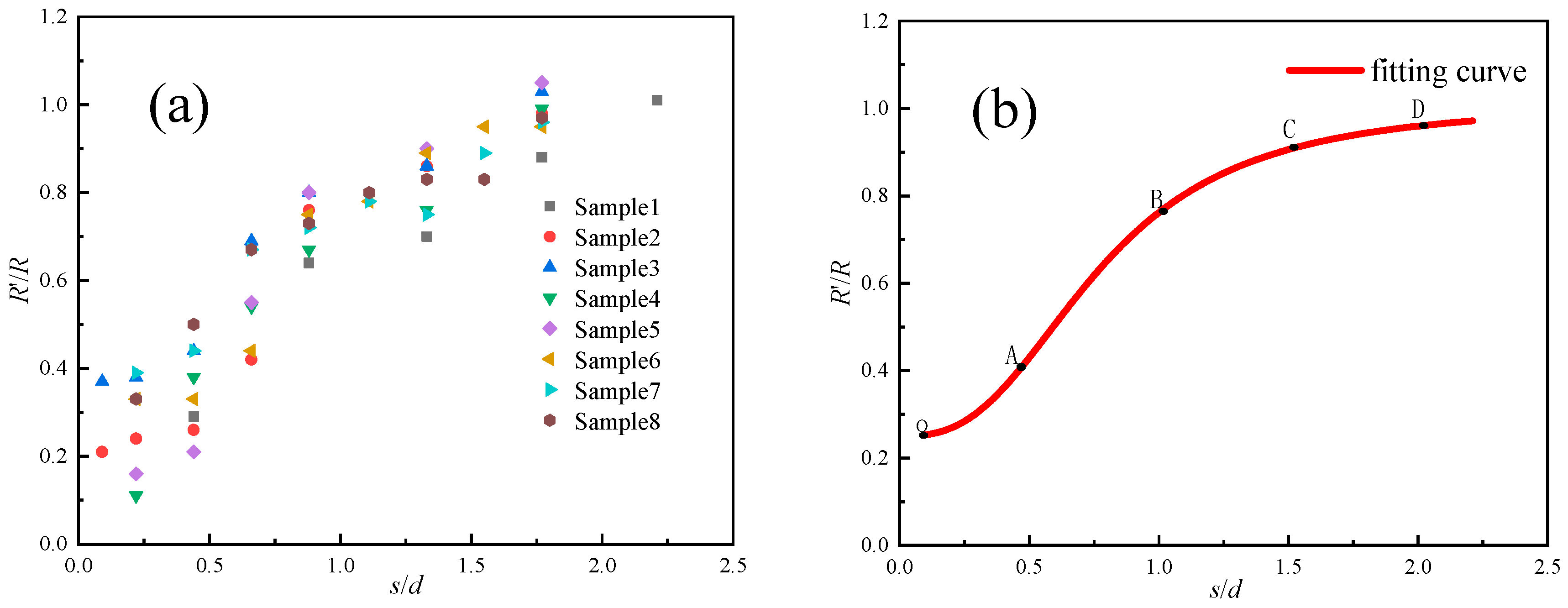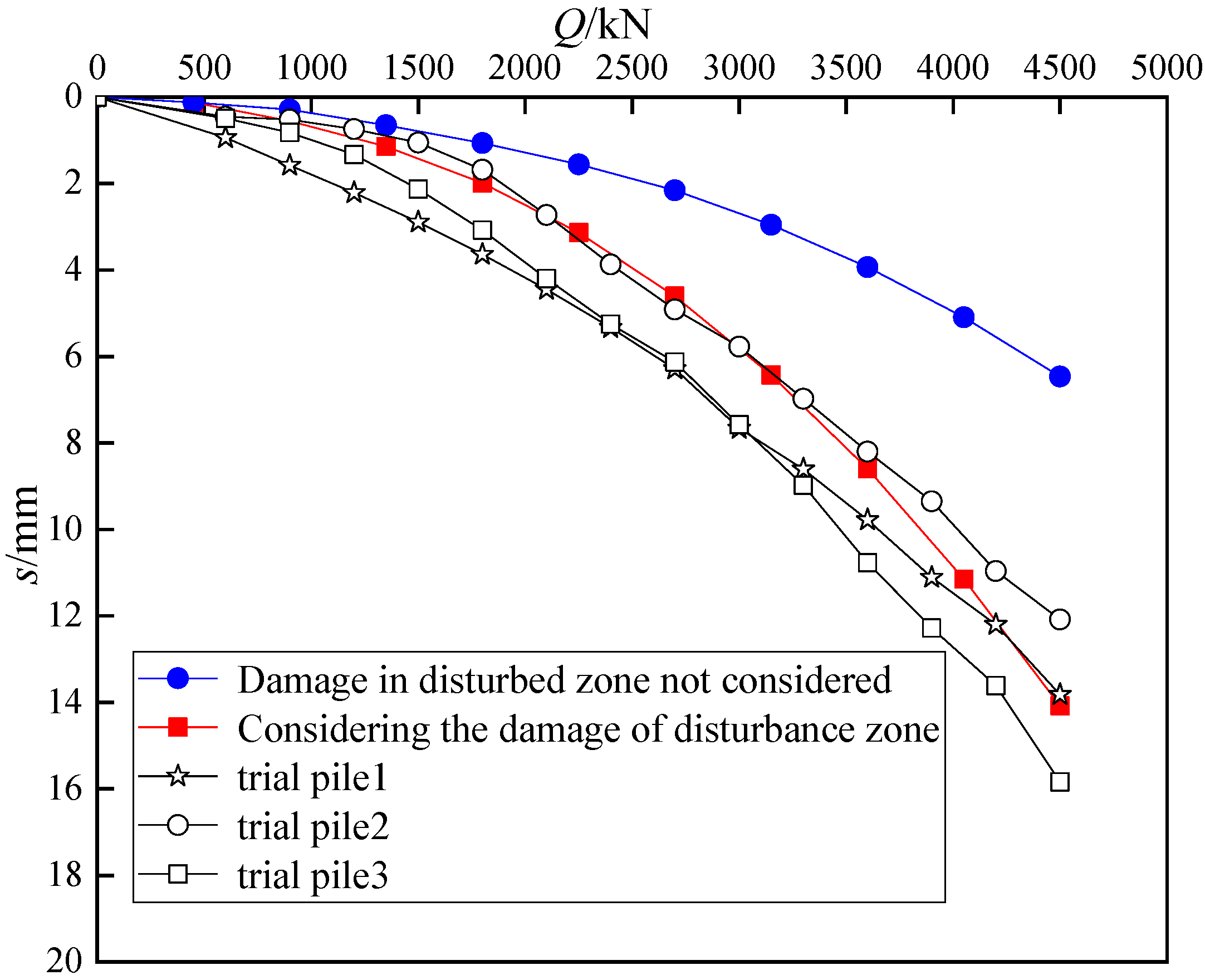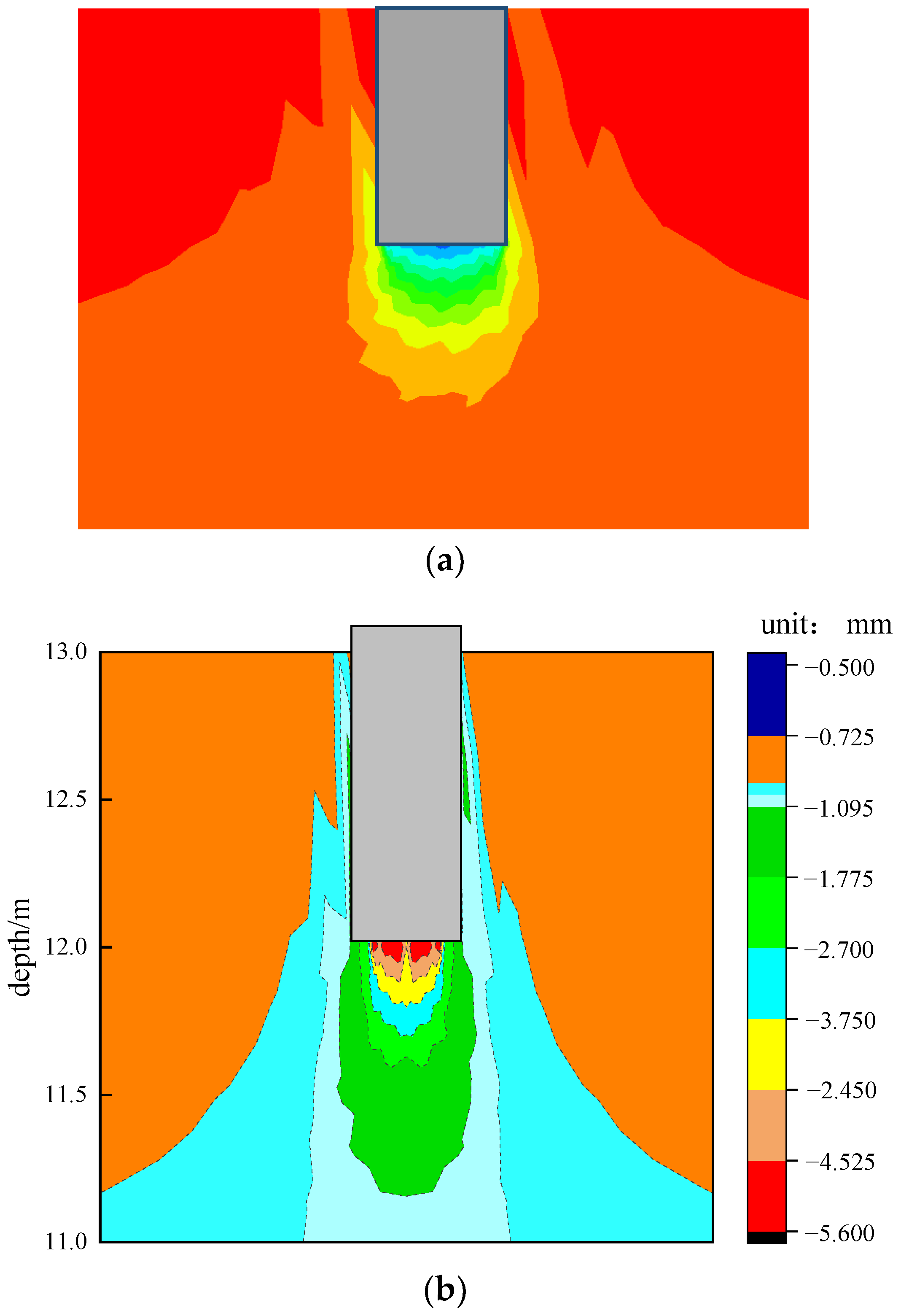Numerical Simulation of Bearing Characteristics of Bored Piles in Mudstone Based on Zoning Assignment of Soil around Piles
Abstract
:1. Introduction
2. Experimental Test of Mudstone around Pile Affected by Pile Driving Damage
2.1. In Situ Dynamic Penetration Test and Scanning Electron Microscope
2.1.1. Engineering Geological Conditions of a Test Site
2.1.2. Comparison of SEM Test Results
2.2. Simulated Indoor Piling and Test Results
2.2.1. Indoor Simulated Dynamic Piling
2.2.2. Penetration Test of Sample Needle after Simulated Indoor Piling
3. Establishment of Static Load Model of ABAQUS Pile
3.1. Thoughts on Establishing a Static Load Model of Pile
3.2. Steps of Model Establishment
- (1)
- Parameter settings of pile-soil components
- (2)
- Constitutive model and parameter selection of different materials
- (3)
- Definition of the model contact surface
- (4)
- Boundary condition setting
- (5)
- Analysis step settings
- (6)
- Mesh subdivision
- (7)
- Selection of iterative algorithm
4. Realization of Numerical Simulation of Pile Static Load Test
4.1. Ground Stress Balance
4.2. Numerical Simulation Loading of Static Load Test
5. Analysis of Numerical Simulation Results
5.1. Comparative Analysis of Numerical Simulation and Measured Static Load Test Curves
5.2. Stress Analysis of Mudstone at Pile End
- (1)
- First, determine a surface that extracts the cloud image, and then click Tool-Display Group-Manager to create a new display group.
- (2)
- Click on the node in the left toolbar for creating the display group and pick it up from the viewport in the following method. Click the cloud surface to pick up. Click the mouse button, and then click to save as a new file name.
- (3)
- Close all of the above windows. Click the query value options. Click the file saved before. The system will query the eigenvalues of the points and save them to the desktop.
- (4)
- Open the excel table to process data. Click the separator. Click Finish once all the delimiters are checked. Delete data on the same coordinates from the exported data to obtain the required XYZ data.
- (5)
- Redraw using the drawing software Origin and adjust the numerical stress gradient to draw a more regular pile end mudstone vertical stress nephogram. The stress is shown in Figure 14b.
5.3. Mudstone Displacement Analysis at the Pile Tip
6. Conclusions
- (1)
- The numerical modeling method for simulating the mudstone foundation’s static load test of pile driving is proposed based on field tests, indoor simulations, and damage theory. This method considers the range of mudstone damaged area and the value of parameters after damage, which is more in line with the actual rock and soil layer situation after dynamic pile driving.
- (2)
- The range of the disturbed damage zone of mudstone is delimited, and the disturbed damage zone is refined. The use of strength ratio and distance ratio is actually the normalization of soil strength around the pile. It is a reasonable method to reduce the calculation parameters in the affected area.
- (3)
- A numerical model of static load test of mudstone driven pile is developed. This method is divided into two kinds of numerical models according to the disturbance damage zone and the non-disturbance damage zone. By comparing the simulation results with the field static load test results, it is found that the numerical simulation static load test curve considering the influence of disturbance damage area is consistent with the measured curve. However, the settlement of the pile top without considering the influence of the disturbance damaged area is too small. Only about half of the former pile bearing capacity is high. When the numerical simulation is used to predict the bearing capacity of a pile driven into mudstone, the bearing capacity of the pile will be overestimated if the disturbance damage to mudstone around the pile is not considered.
- (4)
- The simulation results show that the stress value in the mudstone at the pile end decreases gradually from the pile end to the outside, which conforms to the stress diffusion law. The vertical displacement at the pile end is the largest, with a gradual decrease from the pile end outward and downward.
Author Contributions
Funding
Data Availability Statement
Conflicts of Interest
References
- Rezazadeh, S.; Eslami, A. Empirical methods for determining shaft bearing capacity of semi-deep foundations socketed in rocks. J. Rock Mech. Geotech. Eng. 2017, 9, 1140–1151. [Google Scholar] [CrossRef]
- Elsamny, M.K.; Ibrahim, M.A.; Gad, S.A.; Abd-Mageed, M. Experimental evaluation of bearing capacity and behaviour of single pile and pile group in cohesionless soil. Int. J. Eng. Res. Technol. (IJERT) 2017, 6, 695–754. [Google Scholar]
- Alielahi, H.; Adampira, M. Comparison between empirical and experimental ultimate bearing capacity of bored piles—A case study. Arab. J. Geosci. 2016, 9, 78. [Google Scholar] [CrossRef]
- Irvine, J.; Terente, V.; Lee, L.T.; Comrie, R. Driven pile design in weak rock. In Frontiers in Offshore Geotechnics III—Proceedings of the 3rd International Symposium on Frontiers in Offshore Geotechnics; CRC Press: London, UK, 2015. [Google Scholar]
- Senthil, P.; Dev, H.; Sarwade, D.V. In-Situ Tests for Dams on Soft Sedimentary Formation in Siwaliks. Proc. Indorock 2019, 202–211. [Google Scholar]
- Eslami, A.; Lotfi, S.; Infante, J.A.; Moshfeghi, S.; Eslami, M.M. Pile shaft capacity from cone penetration test records considering scale effects. Int. J. Geomech. 2020, 20, 04020073. [Google Scholar] [CrossRef]
- Fryer, S. High Capacity O-Cell Pile Load Testing in Coal Measures Mudstone; Northern Spire Bridge: Sunderland, UK, 2019. [Google Scholar]
- Terente, V.; Torres, I.; Irvine, J.; Jaeck, C. Driven Pile Design Method for Weak Rock. In Proceedings of the Offshore Site Investigation Geotechnics 8th International Conference, London, UK, 12–14 September 2017; pp. 652–657. [Google Scholar]
- Ma, F.R.; Yang, S.M. Research on the Bearing Mechanism of Mudstone with Soft-Hard Alternant Strata. In Applied Mechanics and Materials; Trans Tech Publications Ltd.: Bäch, Switzerland, 2013; Volume 368, pp. 1718–1721. [Google Scholar]
- Iyare, U.C.; Blake, O.O.; Ramsook, R. Estimating the Uniaxial Compressive Strength of Argillites Using Brazilian Tensile Strength, Ultrasonic Wave Velocities, and Elastic Properties. Rock Mech. Rock Eng. 2021, 54, 2067–2078. [Google Scholar] [CrossRef]
- Hu, Q.; Zeng, J.; He, L.; Fu, Y.; Cai, Q. Effects of displacement-softening behavior of concrete-mudstone interface on load transfer of belled bored pile. Arab. J. Geosci. 2021, 14, 2563. [Google Scholar] [CrossRef]
- Zhang, X.; Fatahi, B.; Khabbaz, H.; Poon, B. Assessment of the internal shaft friction of tubular piles in jointed weak rock using the discrete-element method. J. Perform. Constr. Facil. 2019, 33, 04019067. [Google Scholar] [CrossRef]
- Tian, H.M.; Chen, W.Z.; Yang, D.S.; Yang, J.P. Experimental and numerical analysis of the shear behaviour of cemented concrete–rock joints. Rock Mech. Rock Eng. 2015, 48, 213–222. [Google Scholar] [CrossRef]
- Chen, C.; Gratchev, I. Effects of pre-existing cracks and infillings on strength of natural rocks–Cases of sandstone. J. Rock Mech. Geotech. Eng. 2020, 12, 1333–1338. [Google Scholar]
- Yuan, B.; Chen, M.; Chen, W.; Luo, Q.; Li, H. Effect of pile-soil relative stiffness on deformation characteristics of the laterally loaded pile. Adv. Mater. Sci. Eng. 2022, 2022, 4913887. [Google Scholar] [CrossRef]
- Yuan, B.; Li, Z.; Chen, W.; Zhao, J.; Lv, J.; Song, J.; Cao, X. Influence of groundwater depth on pile–soil mechanical properties and fractal characteristics under cyclic loading. Fractal Fract. 2022, 6, 198. [Google Scholar] [CrossRef]
- Mayoral, J.M.; Pestana, J.M.; Seed, R.B. Modeling clay–pile interface during multi-directional loading. Comput. Geotech. 2016, 74, 163–173. [Google Scholar] [CrossRef]
- Wu, J.T.; Ye, X.; Li, J.; Li, G.W. Field and numerical studies on the performance of high embankment built on soft soil reinforced with PHC piles. Comput. Geotech. 2019, 107, 1–13. [Google Scholar] [CrossRef]
- Zhang, J.; Zhang, Z.; Zhang, S.; Brouchkov, A.; Xie, C.; Zhu, S. Numerical simulation of the influence of pile geometry on the heat transfer process of foundation soil in permafrost regions. Case Stud. Therm. Eng. 2022, 38, 102324. [Google Scholar] [CrossRef]
- Rooz AF, H.; Hamidi, A. A numerical model for continuous impact pile driving using ALE adaptive mesh method. Soil Dyn. Earthq. Eng. 2019, 118, 134–143. [Google Scholar] [CrossRef]
- Qu, L.; Ding, X.; Kouroussis, G.; Zheng, C. Dynamic interaction of soil and end-bearing piles in sloping ground: Numerical simulation and analytical solution. Comput. Geotech. 2021, 134, 103917. [Google Scholar] [CrossRef]
- Cheng, X.; Wang, T.; Zhang, J.; Liu, Z.; Cheng, W. Finite element analysis of cyclic lateral responses for large diameter monopiles in clays under different loading patterns. Comput. Geotech. 2021, 134, 104104. [Google Scholar] [CrossRef]
- Rabat, Á.; Cano, M.; Tomás, R.; Tamayo, Á.E.; Alejano, L.R. Evaluation of strength and deformability of soft sedimentary rocks in dry and saturated conditions through needle penetration and point load tests: A comparative study. Rock Mech. Rock Eng. 2020, 53, 2707–2726. [Google Scholar] [CrossRef] [Green Version]
- Dong, J.; Yang, R.; Guo, C.; Wang, M.; Wu, Y.; Guo, Y.; Zhao, Y.; Li, G.; Xiong, H. In Situ Needle Penetration Test and Its Application in a Sericite Schist Railway Tunnel, Southwest of China. Lithosphere 2021, 2021, 1683781. [Google Scholar] [CrossRef]
- Umantsev, A.R. Bifurcation theory of plasticity, damage and failure. Mater. Today Commun. 2021, 26, 102121. [Google Scholar] [CrossRef]
- Lemaitre, J. How to use damage mechanics. Nucl. Eng. Des. 1984, 80, 233–245. [Google Scholar] [CrossRef]
- Lemaitre, J. A continuous damage mechanics model for ductile fracture. J. Eng. Mater. Technol. 1985, 107, 83–89. [Google Scholar] [CrossRef]
- He, P.; Liu, C.W.; Wang, C.; You, S.; Wang, W.Q.; Li, L. Study on the relationship between uniaxial compressive strength and elastic modulus of sedimentary rock. Adv. Eng. Sci. 2011, 43, 7–12. [Google Scholar]















| Number | Name of Soil Layer | Thickness of Exposed Layer (m) | Bottom Elevation (m) | Characteristics of Rock and Soil Layer |
|---|---|---|---|---|
| ① | backfill | 0.4–5.0 | 1.44–4.17 | Gray brown-yellow brown, local dark brown, slightly wet-wet, loose, mainly composed of clay |
| ③ | silty clay | 0.7–3.4 | 1.12–4.17 | Gray brown~yellow brown, plastic, local soft, medium compressibility, local soft part with high compressibility |
| ⑦ | silty clay | 0.7–4.6 | −3.21–1.08 | Gray brown~yellow brown, plastic. Ferrous oxides were found, occasionally manganese nodules and bands on the kaolinite. |
| ⑮ | silty mudstone full weather zone | 0.4–6.0 | −10.69–1.66 | Brick red~purple red, the original rock structure cannot be identified, the core is plastic~hard plastic clay, with a small amount of breccia, broken block core, hand rub easily scattered, dry drilling without water can be drilled. |
| ⑯ | silty mudstone strong weathering zone | 0.6–9.8 | −12.16–−0.59 | Purple red, structure is still identifiable, the core is mainly breccia~broken block, sandy core, part. Divided into short columns, broken hands, hammer easily broken. |
| ⑰ | silty mudstone middle weathering zone | 5.0–10.0 | −16.16–−4.69 | Brick red, core columnar~long column, local fragmentation~block, core hammer sound dumb, fragile, joint, crack development. |
| Name of Soil Layer | Gravity/kN/m3 | Elastic Modulus/MPa | Poisson’s Ratio | Cohesion/kPa | Internal Friction Angle/° | Friction Coefficient |
|---|---|---|---|---|---|---|
| backfill | 18 | 0.01 | 20 | |||
| silty clay | 19.3 | 2.73 | 0.35 | 22.2 | 10.2 | 0.35 |
| silty clay | 19.7 | 2.77 | 0.33 | 27.7 | 12.9 | 0.35 |
| silty mudstone full weather zone | 20 | 10 | 0.20 | 47.9 | 17.4 | 0.4 |
| silty mudstone strong weathering zone | 23 | 25 | 0.23 | 100 | 40 | 0.4 |
| silty mudstone middle weathering zone | 24 | 35 | 0.20 | 250 | 50 | 0.6 |
| Area | 1 | 2 | 3 | 4 |
|---|---|---|---|---|
| Compressive strength reduction factor | 0.247 | 0.610 | 0.868 | 0.946 |
| elastic modulus reduction factor | 0.109 | 0.458 | 0.802 | 0.922 |
Publisher’s Note: MDPI stays neutral with regard to jurisdictional claims in published maps and institutional affiliations. |
© 2022 by the authors. Licensee MDPI, Basel, Switzerland. This article is an open access article distributed under the terms and conditions of the Creative Commons Attribution (CC BY) license (https://creativecommons.org/licenses/by/4.0/).
Share and Cite
Zhang, Y.; Wang, F.; Bai, X.; Yan, N.; Sang, S.; Kong, L.; Zhang, M.; Wei, Y. Numerical Simulation of Bearing Characteristics of Bored Piles in Mudstone Based on Zoning Assignment of Soil around Piles. Buildings 2022, 12, 1877. https://doi.org/10.3390/buildings12111877
Zhang Y, Wang F, Bai X, Yan N, Sang S, Kong L, Zhang M, Wei Y. Numerical Simulation of Bearing Characteristics of Bored Piles in Mudstone Based on Zoning Assignment of Soil around Piles. Buildings. 2022; 12(11):1877. https://doi.org/10.3390/buildings12111877
Chicago/Turabian StyleZhang, Yamei, Fengjiao Wang, Xiaoyu Bai, Nan Yan, Songkui Sang, Liang Kong, Mingyi Zhang, and Yufeng Wei. 2022. "Numerical Simulation of Bearing Characteristics of Bored Piles in Mudstone Based on Zoning Assignment of Soil around Piles" Buildings 12, no. 11: 1877. https://doi.org/10.3390/buildings12111877





